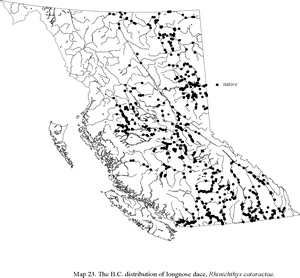Introduction
The longnose dace is a river and creek-dwelling minnow species that is endemic to North America, and is widespread across the continent. It is a bottom-dwelling species that is found in riffles of high gradient, fast flowing streams and associated pools, and sometimes in inshore areas of lakes (gravel/boulder bottoms). In British Columbia, it is found throughout most of the province, but is absent in some regions (coastal islands and most coastal rivers) (McPhail 2007). There are three forms of the species in BC, including the provincially red-listed Nooksack dace. The longnose dace hybridizes with the redside shiner (Richardsonius balteatus) and with lake chub (Couesius plumbeus) in BC. (McPhail 2007). Females can lay between 200 and 1200 eggs.
BC Distribution and Notes
This widespread species is remarkably uniform across North America, except in British Columbia. In B.C., there are three forms of longnose dace — the typical Great Plains form in northeastern B.C., the typical Columbia-Fraser form in the rest of the province, and the Nooksack dace in the extreme southwestern region. The first two forms differ substantially in their reproductive biology and, genetically, they are quite (>4%) divergent. They may be different species. Similarly, the mitochondrial DNA of the Nooksack dace is >2% divergent from that of the Columbia-Fraser longnose dace. Although the Nooksack dace is abundant in western Washington State, it is seriously threatened by urban development in B.C.
Source: Information provided by Don McPhail for E-Fauna BC.
Global Distribution
Found in North America. "Widely occurs from coast to coast of north-central North America: in the east along the mountains to Virginia; in the Mississippi drainage south to Iowa; in the western basin south to northern Mexico; reported from northeastern Nevada; in the inshore waters in all the Great Lakes" (Fishbase 2013).
